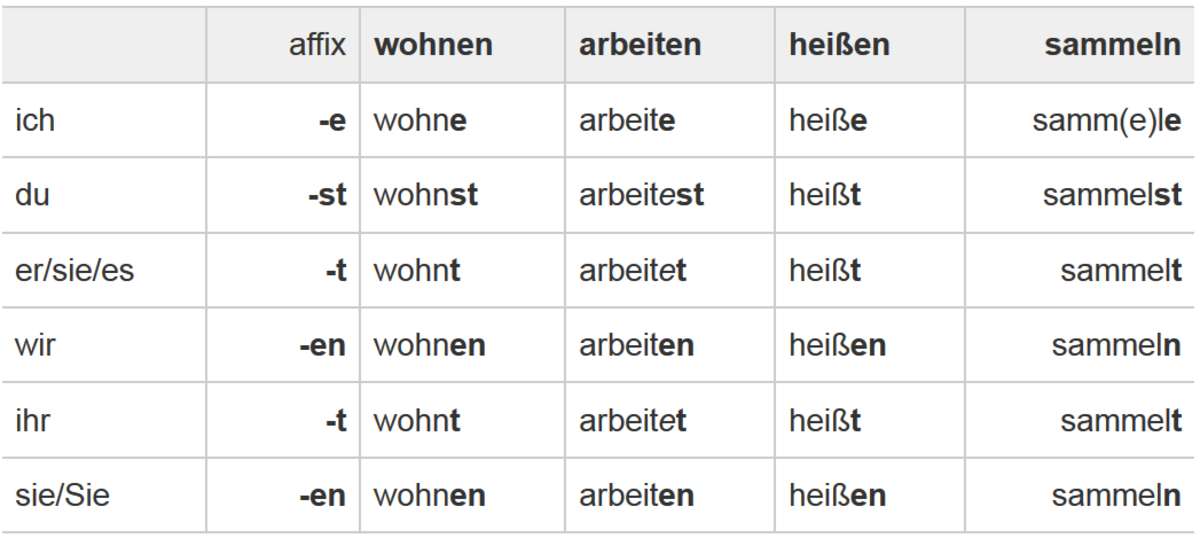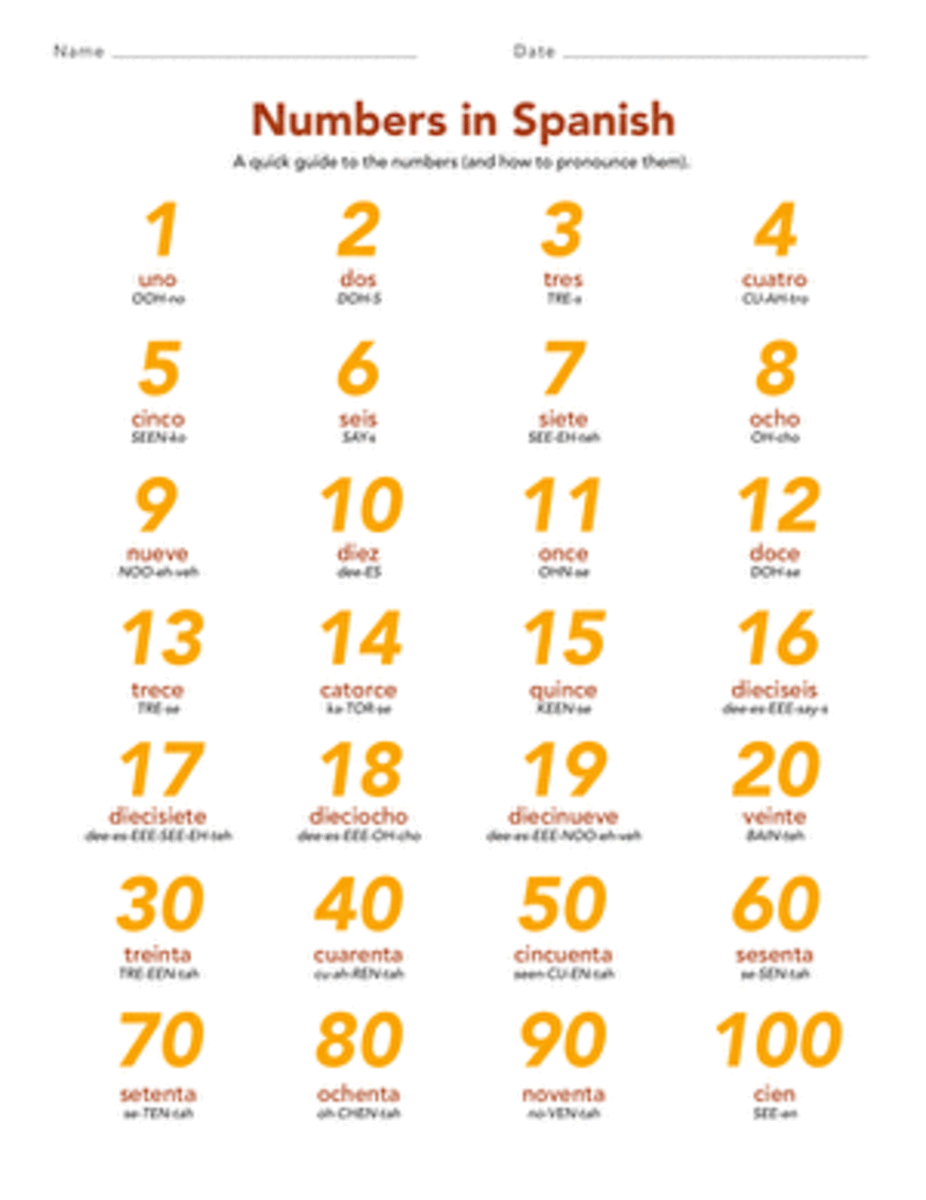Learn Spanish verbs the easy way
Stop memorizing each verb!
There is a popular book listing 500 verbs and all the tenses and forms for each of them. Five hundred verbs is a lot to memorize. It's no wonder students get frustrated trying to learn a language. This book may be a good reference but if you learn verbs in a logical way you won't even need to consult it. Most often in Spanish verbs are taught as vocabulary words and then separately students need to learn how to conjugate them. Our human minds want order and endless lists of words, verbs in this case, is not orderly. Alphabetical order is not the kind of order we need either.
Tag your verbs
Tagging is popular on social media sites and websites in general. Why not tag your verbs then? Each time you learn a new verb it needs to come with tags. This might mean you will have to tag them yourself if your textbook or instructor does not use this non-traditional approach. Here is how to start tagging.
Each time you see a verb you should identify something grammatically significant about it. A beginner in the language may only be able to note if it is an 'ar', 'er' or 'ir' verb. This is a very important start. Then tag it as a 'reflexive' or 'sometimes reflexive' verb. Once you start learning different tenses such as the present, preterit and the participles you will have more tagging to do.
How to group verbs
There are many complaints about how irregular Spanish is. Blame this on its Latin roots. To get around this potential annoyance learn to group verbs right away and avoid having to relearn them. In the present tense there are several groupings of the types of irregularities that can occur in the stems but these do not affect the present tense endings except in four verbs (ser, estar, ir and dar, which are only different in the first person singular).
ar endings: o, as, a, amos, ais, an
er endings: o, es, e, emos, eis, en
ir endings: o, es, e, imos, is, en
*for the four exceptions: oy replaces o in the first person singular
Once these endings are learned they can be attached to the end of the stem of any verb. The trick is making sure the stem is correct. The stem is obtained by dropping off the infinitive ar, er, or ir and making some adjustments when needed. "When needed" is the part we must mentally tag so that we know which verbs need changes in the stems.
Zapatos
Once these endings are learned they can be attached to the end of the stem of any verb. The trick is making sure the stem is correct. The stem is obtained by dropping off the infinitive ar, er, or ir and making some adjustments when needed. "When needed" is the part we must mentally tag so that we know which verbs need changes in the stems. Here are the main groupings of changes:
These changes occur in the last vowel of the stem once the infinitive ending has been removed:
e--> ie preferir --> prefer, the second e becomes ie in all present forms except 1st and 2nd person plural
e-->i pedir --> ped, the e becomes i in all present forms except 1st and 2nd person plural
o--> ue dormir --> dorm, the o becomes ou in all present forms except 1st and 2nd personal plural
Verbs having this type of change are often called "shoe verbs" or "zapatos" because of the shape they make when circled on a chart. Verbs that have this characteristic should be tagged with "zapato".
Common zapatos:
acostarse
acordarse
querer
tener*
decir*
venir*
cerrar
despertarse
empezar
mentir
*other tags apply

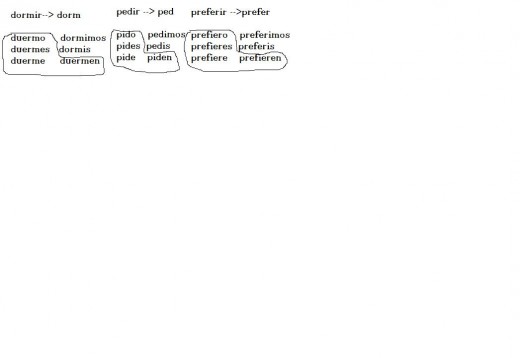
Yo-go
Some verbs have a change that occurs in the 1st person plural that requires a 'g' to be added before the normal 'o' ending. These verbs are also zapatos in the other forms. The shape of the circled verbs will look like a low-top sneaker as opposed to the high-top look of the standard zapato. For example, with tener, we remove the infinitive ir and are left with ten. Rather than just add the 'o' we must add a 'g' first, giving us 'tengo' for the 1st person singular.
Other yo-go verbs
decir (also zapato)
venir (also zapato)
poner
salir
valer
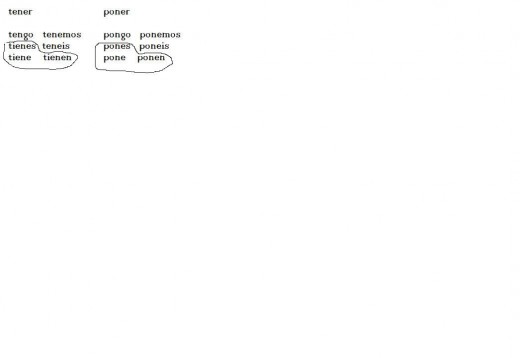
Yo-yo zapato
There are not many of these and they are easily identified as verbs that end in uir. In other words, the remaining stem after the ir is removed ends in a 'u'. For example, huir-->hu and influir-->influ. These verbs add a 'y' before the normal endings following the pattern of other zapatos (that is, they do not affect the 1st and 2nd person plural).
Huir
huyo huimos
huyes huis
huye huyen
Yo-zco
Verbs that end in 'cer' or 'cir' also need to be tagged (In other words, they are er or ir verbs whose stem ends in 'c'). They add a 'zc' before the normal 'o' in the 1st person singular. All other forms are unaffected.
Conocer
conozco conocemos
conoces conoceis
conoce conoce
Yo-oy
There are four verbs that are generally considered to be very irregular. All four of them use a 'y' after the normal 'o' in the 1st person singular. Three of them also require other tags.
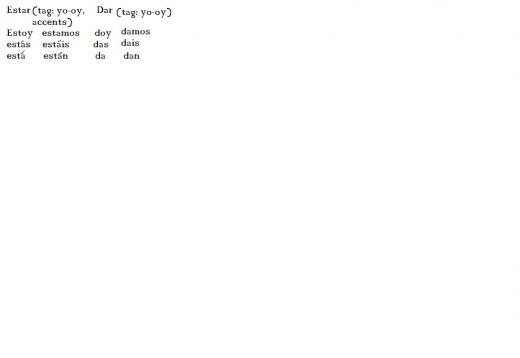
Irregular
The 'irregular' tag should be used very sparingly since most of what people think are irregular verbs can actually be grouped into some category or pattern as we have just seen with zapatos, yo-go and yo-oy. The two verbs that are truly irregular are ir and ser. Both of these come directly from Latin (See "Overview of Latin for a better understanding of Spanish").
Ir is irregular because it has a 'v' and then uses ar endings despite being an ir verb.
Ir (tags: yo-oy, irregular)
voy vamos
vas vais
va van
Ser is irregular. Period. We can compare with the Latin verb esse (infinitive).
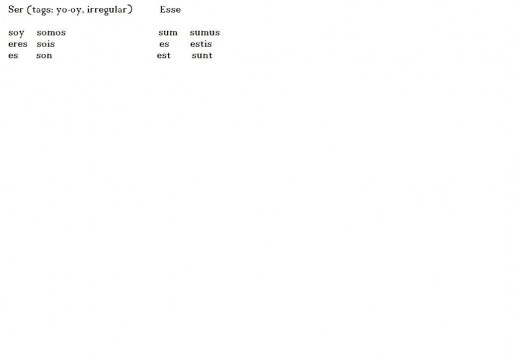
Overview of Latin for a better understanding of Spanish
Get tagging!
These are the tags you will need to group and identify verbs in the present tense. Infinitive verbs that have 'se' added to the end after the ar, er, or ir are reflextive verbs and can be tagged as such. Here are some examples of common verbs not already used as examples:
hacer (yo-go)
soler (zapato)
afeitarse (reflexive)
acostarse (zapato, reflexive)
decir (yo-go, zapato)
empezar (zapato)
obedecer (yo-zco)
incluir (yo-yo)

